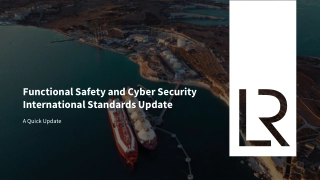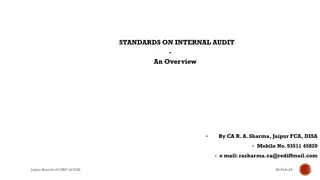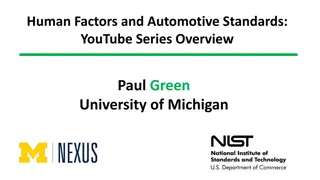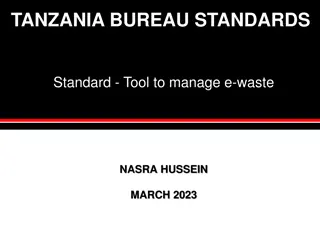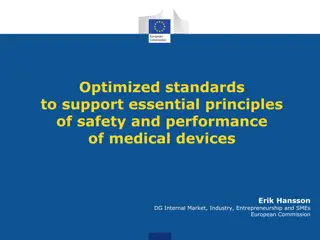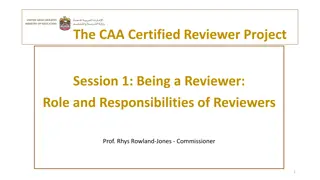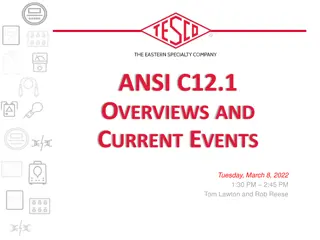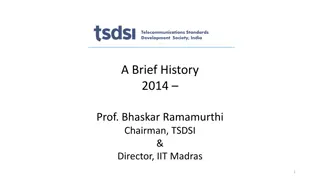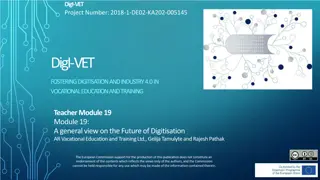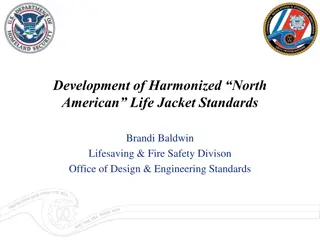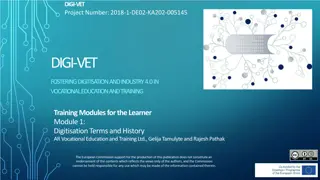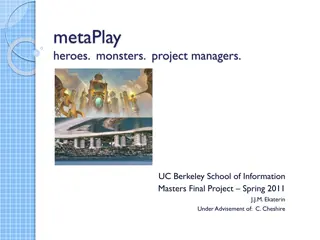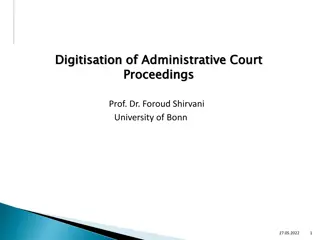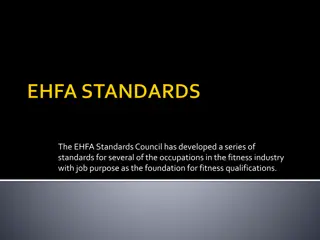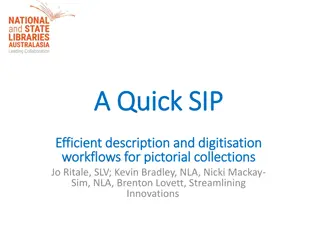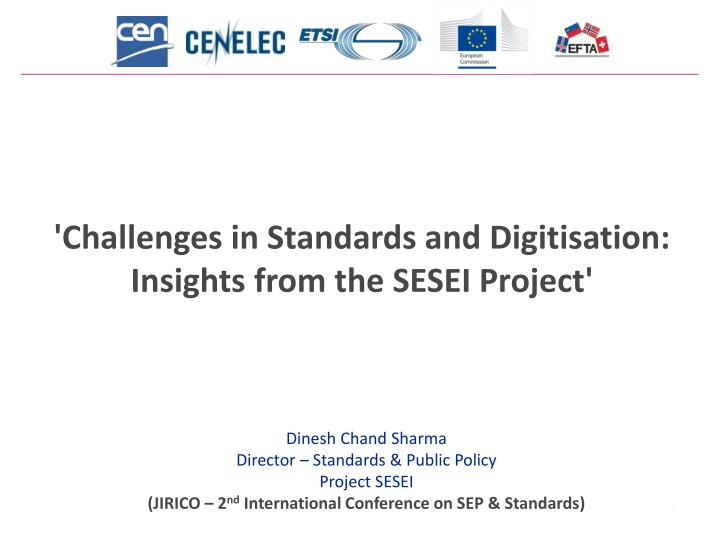
Insights from SESEI Project on Standards and Digitisation Challenges
This content discusses the SESEI Project's insights on challenges in standards and digitisation, focusing on standardisation in Europe, best practices for digital transformation, and the role of global standards in the current economy. It delves into the importance of international collaboration, the integration of ESOs with international standards, and the significance of standards in various sectors such as ICT, electrical equipment, automotive, and smart cities.
Download Presentation

Please find below an Image/Link to download the presentation.
The content on the website is provided AS IS for your information and personal use only. It may not be sold, licensed, or shared on other websites without obtaining consent from the author. If you encounter any issues during the download, it is possible that the publisher has removed the file from their server.
You are allowed to download the files provided on this website for personal or commercial use, subject to the condition that they are used lawfully. All files are the property of their respective owners.
The content on the website is provided AS IS for your information and personal use only. It may not be sold, licensed, or shared on other websites without obtaining consent from the author.
E N D
Presentation Transcript
'Challenges in Standards and Digitisation: Insights from the SESEI Project' Dinesh Chand Sharma Director Standards & Public Policy Project SESEI (JIRICO 2ndInternational Conference on SEP & Standards) 1
Content Project SESEI Standardisation in Europe: Best Practices Digital Transformation: Challenges & What can we do (Digital Single Market DSM) JIRICO 2ndInternational Conference, 10-11 June 2017 Slide 2 2
Project is a permanent presence in India SESEI (Seconded European Standardization Expert in India) is a face for the European standardization community in India Why SESEI: India is a major trade partners for Europe, Increasing role of standards to gain market access and Evolving & complex national regulatory and standardization landscapes Sector: 1. ICT: M2M/IoT, Security, 5G, NFV/SDN, e-Accesibility, eHealth, eCALL 2. Electrical equipment including Consumer Electronics: Smart Grid, Smart Meter, LVDC, Micro- Grid, Lift Escalator 3. Automotive: Connected Cars, ITS, e-Mobility 4. Smart Cities: Mobility, Waste, Energy, ICT.. www.sesei.eu , www.sesei.in , www.eustandards.in JIRICO 2nd International Conference, 10-11 June 2017 Slide 3
Standardisation in Europe JIRICO 2nd International Conference, 10-11 June 2017 Slide 4
International/Global Standards - It s a time of global economy [globalisation] - Standards are the valuable tool for global trade JIRICO 2nd International Conference, 10-11 June 2017 Slide 5
ESOs are integrated with International To avoid duplication of work at International and European levels and to aim for a identical worldwide and European standards CEN: 32% of portfolio identical to ISO Vienna Agreement with Chemistry, Material, Energy, Environment, Transport, Construction, Services, eMobility etc CENELEC: 72% of portfolio identical to (+ another 6% based on) IEC standards Frankfurt Agreement with Electricity, Electro-technical MoU with ITU Information & Communication Technologies (ICT) Founding Partner to 3GPP & oneM2M JIRICO 2nd International Conference, 10-11 June 2017 Slide 6 6
Standards vs Legislation Standards: Legislation: 1. Voluntary & Consensual 1. Mandatory & Imposed by Law 2. Developed by independent organisations 2. Established by public authorities 3. Revised every 5 years or when SDO decide 3. Revised when legislators decide 4. Provide specifications and test methods (interoperability, safety, quality, etc.) 4. Gives requirements to protect public interests JIRICO 2nd International Conference, 10-11 June 2017 Slide 7
Regulation 1025/2012 Regulation is on European Standardization Sets legal framework for standardization in Europe Possibility to finance EU level stakeholder organisations: SME, consumers, environmental and social interests Financing ESOs (operating grants and action grants) and NSBs (in case of joint actions with ESOs including translation of ENs) Confirms importance of developing voluntary European Standards for services Annual Union Work Programme for European standardisation (planning future mandates and strategic priorities) Recognises 3 European Standards Organizations (ESO) CEN, CENELEC and ETSI JIRICO 2nd International Conference, 10-11 June 2017 Slide 8
European Standards The European Commission does not draft European standards! CEN, CENELEC and ETSI do One European Standard replaces 34 different national standards in Europe, conflicting standards are withdrawn Standardisation is a form of self regulation Interested parties come together and agree voluntarily on technical matters Compete more efficiently by ensuring the interoperability of their products EU legislation makes reference to Standards Direct reference: mandatory but mandatory for specific use Indirect reference => New Approach JIRICO 2nd International Conference, 10-11 June 2017 Slide 9
New Approach Objective: remove barriers to trade How? By task sharing: Legislation: mandatory, stable, predictable and safeguarding public interest (via listing the essential requirements) Protection of health, safety, environment and consumers Standards: voluntary, constantly updated to the state-of-the-art, predictable, harmonising the technical specifications JIRICO 2nd International Conference, 10-11 June 2017 Slide 10
Regulation/Legislation: Best Practices Smart Regulation Better Regulation EU follow-s the principal of Better/Smart regulation: Design EU policies and laws to achieve their objectives at minimum cost and ensure that policy is prepared, implemented and reviewed in an open, transparent manner, well informed by the best available evidence and backed up by involving stakeholders Before EU takes action the Commission publishes roadmaps and inception impact assessments which Describe the planned new initiatives and evaluations of existing legislation. examine the potential economic, social and environmental consequences of proposed action through Impact assessments Regulatory Scrutiny Board (RSB): review the impact assessments reports/results REFIT (Regulatory Fitness and Performance Programme) to make EU law simpler and to reduce regulatory costs, thus contributing to a clear, stable and predictable regulatory framework supporting growth and jobs Sufficient transition period for standards 3 years and for any new/amended legislation it is 2 years: Concurrent application of both old and new standards are allowed during this transition period of three years post legislation. JIRICO 2nd International Conference, 10-11 June 2017 Slide 11
ICT Standards - Digital Transformation Challenges and What we can do? EU - Digital Single Market (DSM) JIRICO 2nd International Conference, 10-11 June 2017 Slide 12
ICT Standards Work Together to ensure Interoperability and backward compatibility Economies of Scale is Key and it extend choice to consumer between Products Help authorities to offer cross border and/or international services Eliminate fragmentation and Vendor Lock-in JIRICO 2nd International Conference, 10-11 June 2017 Slide 13
The world is changing The Challenges: changing economy: growing importance of services digital transformation, convergence: Everything is becoming Smart ICT [IoT] To remain relevant, standards must be timely, market-driven and produced in an inclusive way JIRICO 2nd International Conference, 10-11 June 2017 Slide 14
19 April 2016 Package: DSM Communication on Digitising European Industry Communication on European Cloud initiative Vision document and framework for future actions Communication on the e-Government Action Plan Digital transformation of public services Communication on ICT standardisation priorities for the DSM [COM(2016) 176] JIRICO 2nd International Conference, 10-11 June 2017 Slide 15
2 pillar-plan 2.- Delivery 1.- Priority setting Identification of priority building blocks 1. Cloud Computing 2. Internet of Things 3. 5G 4. Cybersecurity 5. Data High-level political process validation, monitoring , update of actions 1. Working closely with std Community 2. Involving Council & Parliament 3. Improving EU support for priorities (H2020, CEF, pilots) 4. Fair and non-discriminatory access - (IPR/SEPs) 5. Stronger international EU's presence & cooperation 2 parts need to be pushed together with stakeholders at EU and international level 16 JIRICO 2nd International Conference, 10-11 June 2017 Slide 16
Joint Initiative on Standardisation European Standards for the 21st Century: COM(2016) 358 dated 1/6/2016 The Joint initiative on Standardisation! An initiative driven by all stakeholders (EU and EFTA Member States, standards organisations and bodies, European industry and industry associations, SMEs, and societal stakeholders)in a collaborative, open, highly inclusive and transparent manner : Signed on 13/6/2016 1. Common vision of standardisation 2. 15 actions/case studies to be delivered by 2019 JIRICO 2nd International Conference, 10-11 June 2017 Slide 17
What can/should we do? Priority areas: 1. Awareness, Standardisation System i.e. increasing the use of standards and participation in the process at all levels Education and Understanding about the 2. Coordination, Cooperation, Transparency, Inclusiveness, i.e. ensuring adequate, high-quality, user-friendly and timely release standards 3. Competitiveness and International dimension, i.e. standards supporting competitiveness in the global markets. JIRICO 2nd International Conference, 10-11 June 2017 Slide 18
Conclusions Standardisation is a form of self regulation and is a tool to: create markets as large and homogenous as possible to allow for economies of scale Compliance with standards in support of regulation implies: the right to place a device on the market , that is to offer it for sale Impact assessment and sufficient transition period of 2-3 year is important to help industry getting ready with its proper implementation ICT Standards need to be global considering the fact of interoperability hence it is utmost important to have: Standards Portfolio Harmonization with Global Standards Raising awareness and visibility plays an important role in strengthening trade JIRICO 2nd International Conference, 10-11 June 2017 Slide 19
Thank you! All about European Standards, ICT Standardisation, http://ec.europa.eu/growth/single-market/european-standards/index_en.htm http://ec.europa.eu/growth/sectors/digital-economy/ict-standardisation_en http://sesei.eu Contact Details: Dinesh Chand Sharma (Seconded European Standardization Expert in India) Director Standardization, Policy and Regulation European Business Technology Centre, DLTA Complex, South Block, 1st Floor, 1, Africa Avenue, New Delhi 110029 Mobile: +91 9810079461, Tel: +91 11 3352 1500, dinesh.chand.sharma@sesei.eu www.sesei.eu JIRICO 2nd International Conference, 10-11 June 2017 Slide 20


